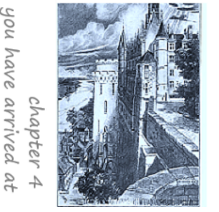 In a fertile Valley, once known as the orchard of France, entered by a series of bridges, ramps, and doorways large enough to accommodate horses and carriages, the Chateau d'Amboise looms over the Loire River. No traces remain of the Gallic, Roman, and Feudal fortresses that once occupied this spectacular site.
In a fertile Valley, once known as the orchard of France, entered by a series of bridges, ramps, and doorways large enough to accommodate horses and carriages, the Chateau d'Amboise looms over the Loire River. No traces remain of the Gallic, Roman, and Feudal fortresses that once occupied this spectacular site.
The Chateau's massive walls and great round tower dwarf houses and river boats below. One high Tower overlooks the Loire River; the other high tower overlooks the Amasse River. In the late 15th century, inside this impregnable fortress, concerts were held in a richly adorned music room, and gardens flourished along the ramps on which armies marched to and fro.
About 28 kilometers along the Loire River from the Chateau D'Ambois, at Château de Plessis-lez-Tours, Charles VIII and his wife, Anne of Brittany, set up an atelier for Court Painter, Jean Bourdichon, creator of stained glass windows, illuminated manuscripts, and over 40 now lost paintings. Charles and Anne also supported manuscript illuminator Jean Poyer; the illuminator known as the Master of Jacques de Besançon; and the Master of Anne de Bretagne, the artist, whose unicorn tapestries now grace the Cloisters.
Returned from his ill-fated attack of Naples, brought with him an Italian Architect, Domenico da Cortona, and an Italian designer of gardens. Soon, he began renovating Chateau d'Amboise in Renaissance style. There is a legend that retreating from Naples, in the battle of Fornovo, not far from the Apennines, baggage was lost that contained Charles VIII's jeweled helmet, a portable altar, and a Book of Hours.


 In a fertile Valley, once known as the orchard of France, entered by a series of bridges, ramps, and doorways large enough to accommodate horses and carriages, the Chateau d'Amboise looms over the Loire River. No traces remain of the Gallic, Roman, and Feudal fortresses that once occupied this spectacular site.
In a fertile Valley, once known as the orchard of France, entered by a series of bridges, ramps, and doorways large enough to accommodate horses and carriages, the Chateau d'Amboise looms over the Loire River. No traces remain of the Gallic, Roman, and Feudal fortresses that once occupied this spectacular site.

